How to Create Furniture Content that Converts in an AI Era
Jack Young
- Last Updated: 17 July 2025
Table of Contents
Key Takeaways - Creating Content that Converts
- Define Purpose & Audience: Know exactly who you’re targeting and what action you want them to take.
- Prioritise Mobile & UX: Ensure your content is optimised for mobile devices and accessibility to maximise reach and engagement.
- Research & Fill Gaps: Use data-driven research to identify content gaps, align with user intent, and address real customer questions.
- Structure for AI & Humans: Use clear headings, logical flow, and concise formatting for both human readers and AI parsing.
- Optimise for Search & AI: Implement strong SEO practices, structured data, and E-E-A-T signals to boost visibility in AI-driven search.
- Promote Proactively: Distribute your content across multiple channels, social, email, partnerships, and paid media to amplify reach.
- Measure What Matters: Track performance with modern KPIs, including AI visibility, engagement, conversions, and revenue.
- Mitigate AI Risks: Always review AI-generated content for accuracy, originality, and brand voice to protect credibility.
- Stay Legal & Ethical: Follow copyright, privacy, transparency, accessibility, and honest marketing standards to build trust and avoid penalties.
TL;DR - Creating Content in an AI Era
To truly win in the AI-driven era of furniture retail, your content must be carefully crafted from start to finish.
Begin by defining a clear purpose and deeply understanding your audience, segmenting them by needs, preferences, and pain points. This ensures every piece of content resonates and effectively drives action.
Next, research topics to identify high-impact themes and content gaps, always aligning your content with user intent and the evolving demands of AI-powered search. When planning and structuring your content, use logical headings, concise sections, and prioritise mobile-first design to maximise readability and accessibility for all users.
Building trust and authority is vital to your content’s success. Showcase genuine experience, expertise, and maintain transparent policies alongside a strong brand voice. Don’t just publish, but actively promote your content across social media, email, partnerships, and paid channels to amplify reach and earn valuable backlinks. If using AI tools for content creation, always apply human oversight to ensure accuracy, originality, and brand consistency, thereby protecting your reputation.
Measure what matters. Track engagement, branded search visibility, AI Overview presence, conversions, and revenue. Use these insights to continually refine your strategy. Additionally, uphold all legal and ethical standards, respecting copyright, privacy, accessibility, and honest marketing regulations to build lasting trust with your customers.
Finally, keep your content fresh and up to date. Anticipate follow-up questions and build comprehensive topic clusters to establish your brand as the go-to resource in furniture. By adopting this holistic, data-driven, and audience-first approach, your content will not only be discoverable and credible but will also consistently drive real business results in our evolving industry.
Why Your Furniture Content Needs to Adapt to the AI Era
Are you struggling to get your furniture website noticed—not just by people, but by AI-powered search engines?
The way customers discover and choose furniture online is changing fast. It’s not enough to rank on page one of Google. Today, AI-driven platforms like Google’s AI Overviews deliver answers directly in the search results, meaning users may never click through to your site. Zero-click searches are becoming an increasingly common occurrence.
AI hasn’t just made things a bit more difficult. It has raised the bar. What was once considered by some to be the best practices before is now the baseline. The focus has shifted from simply “beating competitors” to truly “being the best resource” in your niche. If your content isn’t optimised for these new AI-powered platforms, you risk being invisible.
Whether you’re writing blog posts, guides, or product descriptions, these strategies will help your content get discovered, cited, and remembered by both AI and your future customers.
Let’s make sure your furniture business isn’t left behind in the AI search revolution.
Mobile Optimisation: Design First for the Small Screen
Why discuss mobile optimisation before content creation?
Your website must be fully responsive, meaning its design and content seamlessly adapt to any screen size, from the smallest smartphone to large desktop monitors. This is non-negotiable because Google’s mobile-first indexing policy uses the mobile version of your site for indexing and ranking.
The need to be mobile-first design-minded is just for Google’s sake. A significant and continually increasing portion of your customers will browse and shop on mobile devices. A clunky, frustrating mobile experience—characterised by tiny, unreadable text, non-clickable buttons, images that don’t load properly, or slow performance—will lead to immediate abandonment. AI systems, which are designed to deliver the best possible user experience, favour and promote mobile-friendly sites.
Define Your Purpose and Audience
Purpose
What is the main reason for producing this piece of content?
Is it to share information, entertain the reader or viewer, or capture leads for your business?
With AI now influencing discovery, you must also consider how AI agents will interpret your content. Are you enabling AI to accurately classify your purpose through structured data, clear messaging, and consistent formatting?
Who Is the Content For?
Who are you creating the piece for? The answer should not be everyone or all of your customers.
Your business should have a clearly defined core audience. They see value, can afford, and want your products or services. This core audience will have certain demographics, interests, and pain points. Understanding your target audience allows you to tailor content that resonates, making them feel like, “This company gets me.”
Audience Segmentation
Often, your audience isn’t a single group. Within your core audience, you may have sub-groups with slightly different needs and preferences—this is where audience segmentation comes in. Segmentation means dividing your audience into smaller groups based on shared characteristics, such as style preferences (modern vs. traditional) or life stage (first-time buyers, growing families, etc.).
By segmenting your audience, you can speak directly to each group’s needs and interests, making your content more relevant and compelling. Avoid treating all audiences as one. The adage holds true: “Marketing to everyone is marketing to no one.” When you try to be all things to all people, you’ll be nothing to anyone.

Defining and segmenting your audience not only helps you create more relevant content for your core customers but also ensures that both search engines and AI-powered tools can better match your content to the right people.
In-depth, audience-focused content allows AI systems to use semantic referencing—the understanding of context, intent, and relationships within your article—to accurately determine who your content is for. This enables them to show your content to the most relevant users. In essence, the more precisely you segment and communicate to your audience, the better AI systems can interpret and deliver your content to those most likely to engage.
Desired Outcome
What do you want the reader to do after reading your content?
Do you want them to learn something new or take a specific action, for example? Be explicit about your intended outcome—whether it’s making a purchase, signing up for a newsletter, or sharing your content.
Additionally, think about how AI models might summarise your content and what key actions or messages they will highlight.
AI acts as a matchmaker by analysing the searcher’s intent and surfacing content that best matches that intent. When your content is tailored to the needs and questions of buyers at different journey stages, it’s more likely to be delivered to the right audience, driving engagement and conversions.
Define Your Purpose and Audience Example
You can be as in-depth as you like or keep it simple, as in the example below, but you need clear direction. There’s a sweet spot between being too specific and too broad, which sometimes takes testing to find.
Purpose:
To educate first-time apartment buyers or renters on how to choose space-saving furniture for small living spaces.
Who is the content for?:
Young professionals (ages 22–30) moving into their first city apartment, who value both style and functionality but have limited square footage and budget.
Desired Outcome:
After reading, the audience should feel confident selecting multi-functional furniture and be encouraged to download a free “Small Space Furniture Guide” or browse your curated product collection.
Conduct Audience-Driven Content Research
Having defined your purpose and target audience, it’s time to leverage search engine results pages (SERPs) for in-depth topic research. Analysing top-ranking pages—both from competitors and in AI-generated overviews—reveals valuable insights to inform your strategy and highlight content gaps. You can also ask AI search engines the kinds of questions your customers might ask around your topic keywords and observe which pages or sources they cite.
Content and Structure
Topic and Relevancy: Does the content directly answer the user’s specific search query? Are the key questions and subtopics addressed to ensure alignment with the search intent?
Structure and Flow: Is the content organised logically and easy to follow? Does the flow of information maintain reader interest throughout?
Comprehensiveness: Does the content provide in-depth coverage of the topic? Are there any gaps or related areas that could be expanded to enhance the value of the content?
Engagement and Style
- Writing Style: Is the tone formal, informal, or conversational? Choose a writing style that resonates with your target audience.
- Voice and Tone: Does the content reflect a unique brand personality? Adjust your voice to be authoritative, informative, or persuasive as appropriate to your brand.
- Use of Examples and Stories: Are real-world examples or stories used to enhance engagement? Consider incorporating these to improve readability, memorability, and to strengthen E-E-A-T (Experience, Expertise, Authoritativeness, and Trustworthiness), which we discuss later.
SEO Optimisation
- Keyword Integration: Are keywords used naturally and strategically throughout without keyword stuffing?
- Headings and Subheadings: Does the structure improve readability? Are relevant keywords included in headings?
- Image Optimisation: Are images relevant, high-quality, and properly optimised with descriptive alt text for search engines and accessibility?
Overall Impact
- Call to Action (CTA): Are there clear calls to action, prompting users to take the next step, such as subscribing to a newsletter or visiting a product page?
- Shareability: Is the content designed to be shareable, with elements like infographics that encourage social sharing?
- Learning Points: What are the key takeaways or insights? Ensure your content delivers similar or greater value to your audience.
Plan Out Your Content
"Give me six hours to chop down a tree, and I will spend the first four sharpening the axe."
Abraham Lincoln.
Structure and Planning Methods
There is no single “best” way to plan content. You need to experiment and find an approach that works for you. The most common approach is to create an outline with your main topic, subheadings, and supporting points. Whatever approach you decide on, the key is to have a structure that helps you:
- Organise ideas logically
- Ensure a smooth flow of information
- Include key points, subtopics, and supporting evidence
- Plan visuals (images, videos, infographics)
Structured content benefits both your human audience and AI systems. For users, clear organisation improves readability, reduces cognitive load, and enhances user experience, often leading to longer dwell times and lower bounce rates. For AI, well-structured content enables faster and more accurate parsing, making it more likely your information will be cited in AI Overviews or used for direct answers. Remember, your content isn’t just for readers anymore—it’s also a valuable data source for AI.
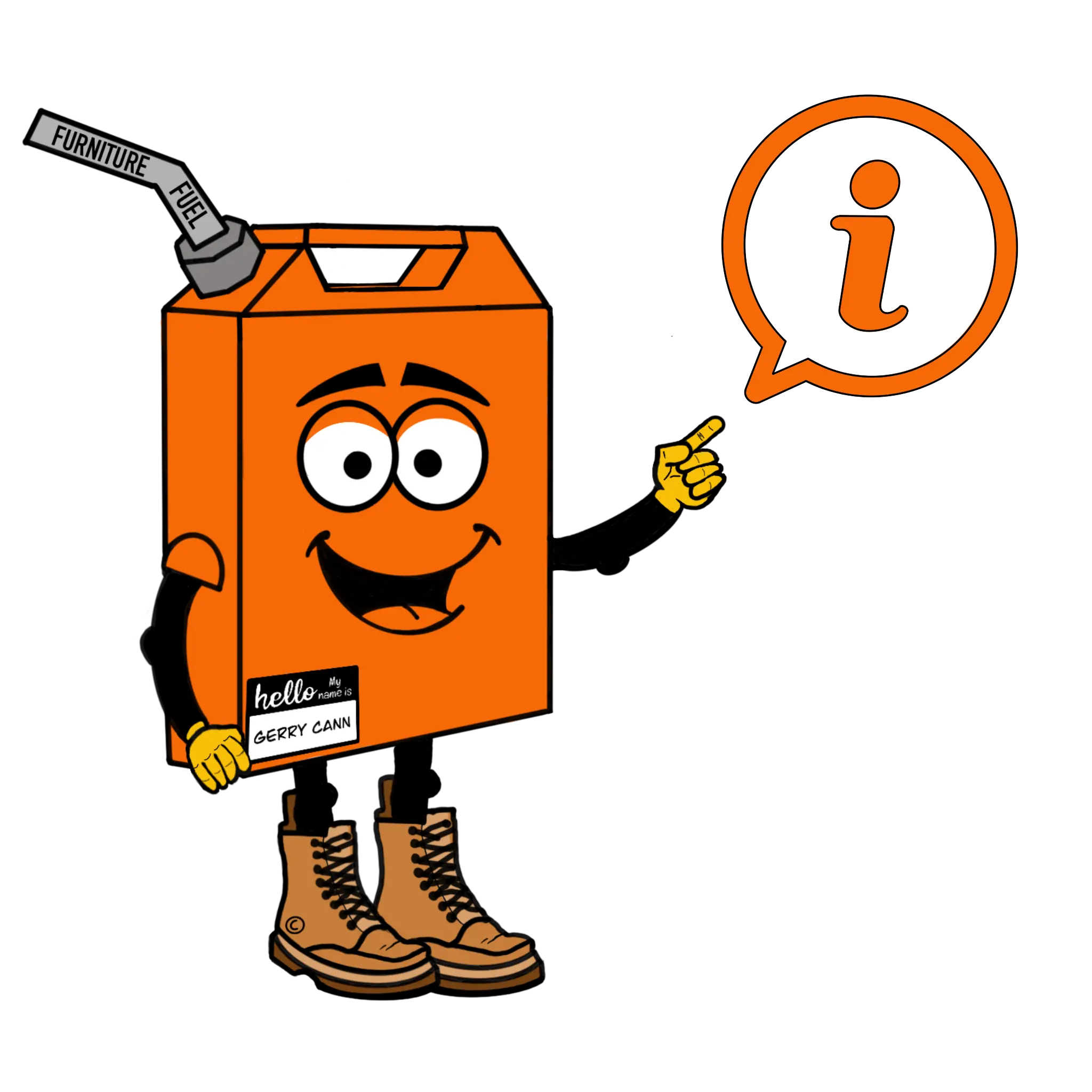
AI parsing, also known as AI document extraction, is the process of using artificial intelligence to automatically extract data from documents, converting it into a structured format
Content Length
There is no perfect content length. The ideal length depends on the topic, keyword targeting, and industry. What matters most is that your content is:
- Easy to skim and digest (use short paragraphs and single-idea chunks)
- Clear and purposeful (address user intent and break down complex ideas)
- Optimised for mobile readability
Dense blocks of text cause reader fatigue and make it harder for both humans and AI to extract value. Instead, break information into manageable sections, always keeping the reader’s goal and search intent in mind.
Ultimately, understanding user intent—why someone is searching for this information—should guide both your content’s structure and its length.
Content Headings Structure
Headings are like signposts guiding readers, search engines, and AI through your content. Well-crafted headings break information into digestible sections, making content easier to read and navigate. But their importance goes beyond user experience. Clear, descriptive headings send strong signals about your main themes and subtopics, helping search engines and AI models understand your content’s organisation and extract specific answers.
H1 and Title Tag: A Powerful Duo
The H1 heading and the title tag (the title displayed in search engine results) often work together to guide relevance. While they don’t have to be identical, ensuring both elements accurately reflect your core message strengthens its overall SEO impact.
What are Title Tags?
Title tags are HTML elements that specify the title of your webpage. They appear in search engine results and browser tabs. While title tags and headlines can be similar, title tags are typically shorter and must be optimised for search engines.
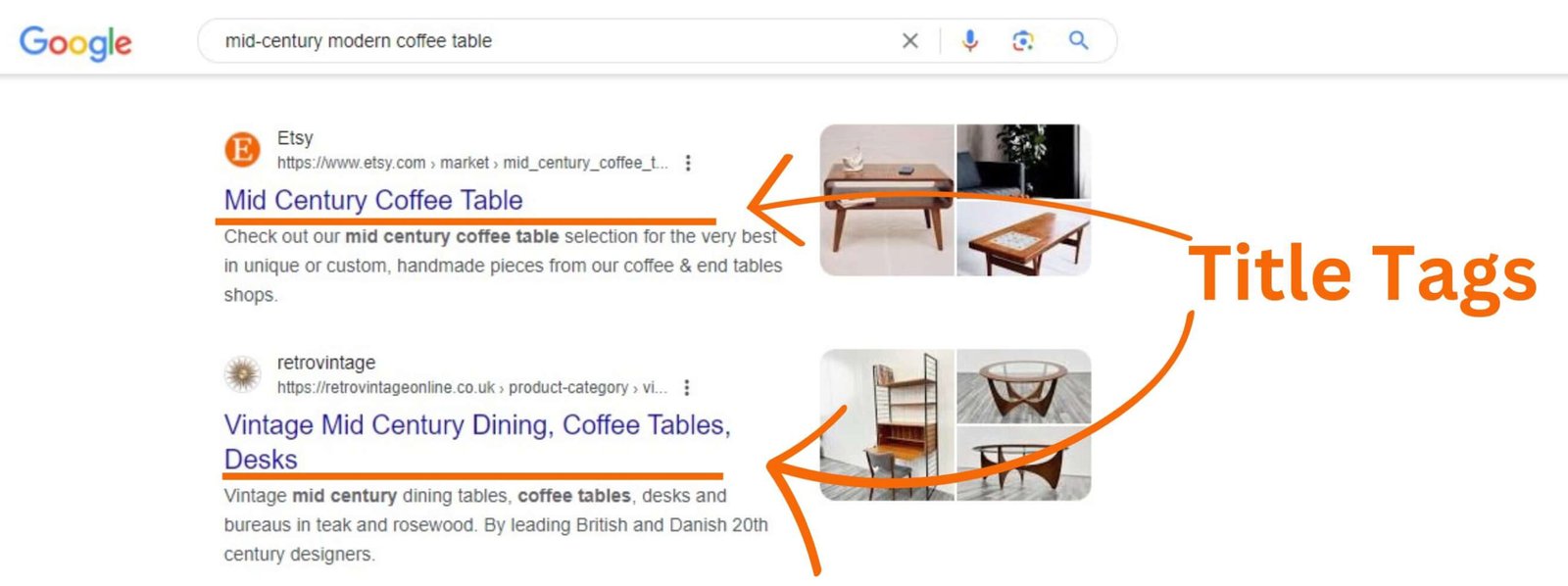
Title Tag Length
While there’s no strict character limit for title tags, keeping them ideally under 60 characters helps ensure they display fully in search engine results pages (SERPs) and don’t get truncated. Truncation is where search engines often cut off titles that exceed a certain pixel width. This varies slightly but is typically around 580 pixels (approximately under 60 characters).
Use the Headings H1-H6 in a logical order.
H1: The top-level heading, typically your webpage’s or blog post’s title. There usually is only one H1 tag per page.
H2: These headings divide the content into key sections addressing your topic’s different aspects. Use H2 tags to break down your H1 topic into clear subtopics.
H3: H3 headings further subdivide the H2 sections by providing details or explanations on specific points. Use H3 tags to elaborate on the information within each H2 section.
H4-H6: These lower-level headings are used for further subheadings within H3 sections. H4 can be used if an H3 section covers a complex topic with several sub-points. H5 and H6 tags are used even less frequently than H4. They might be suitable for very specific details within an already well-structured H4 section.
Example of logical H-tag usage:
H1: The Ultimate Guide to Choosing the Perfect Sofa for Your First Home
H2: Understanding Your Needs and Budget
- H3: Defining Your Style Preferences
- H4: Modern, Minimalist, etc.
- H3: Considering Your Budget and Financing Options
- H4: Interest-free, Buy Now Pay Later, Cash, Credit card.
H2: Choosing the Right Size and Material
- H3: Measuring Your Space for Optimal Sofa Placement
- H3: Selecting Durable and Comfortable Materials
- H4: Fabric, Leather, velvet etc.
H2: Finding the Perfect Balance of Style and Comfort
- H3: Top Tips for Trying Out Sofas in Stores
- H3: Considering Long-Term Comfort and Durability
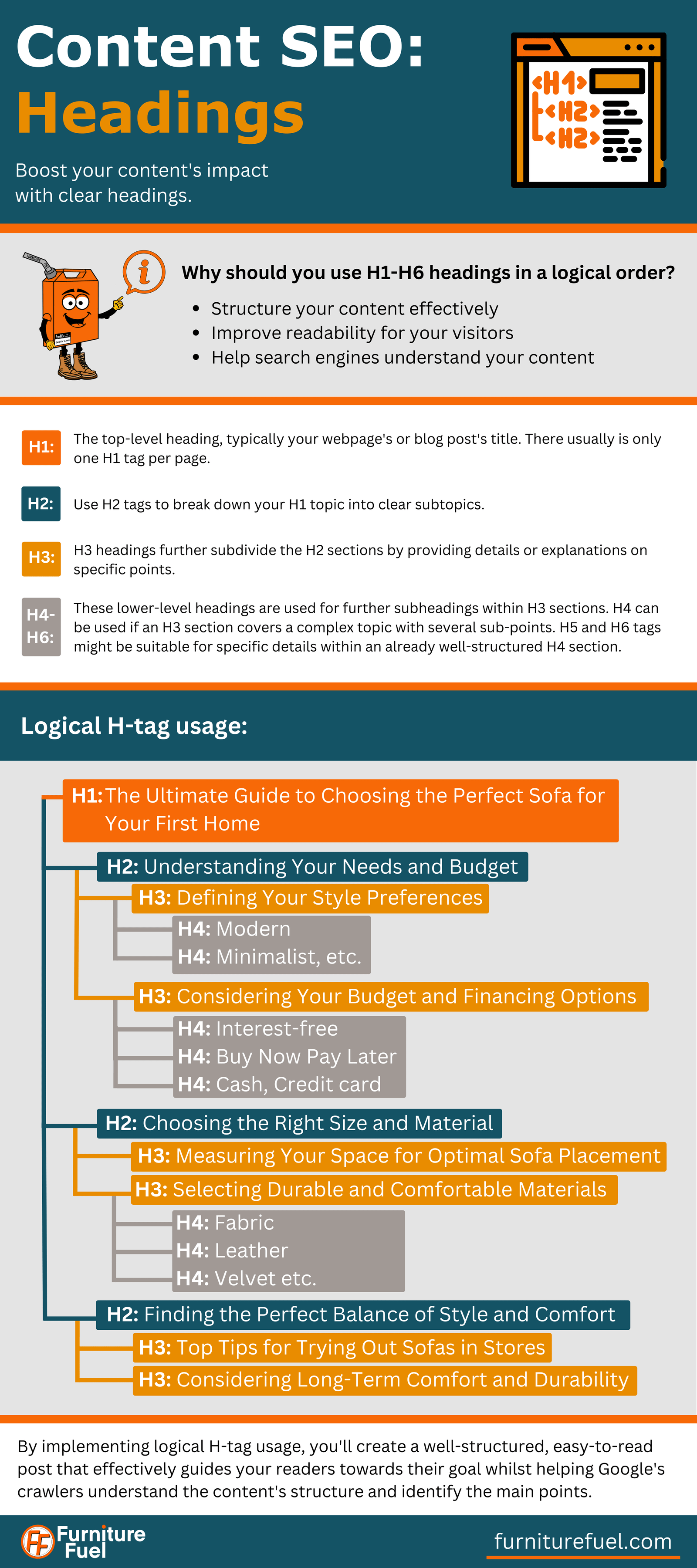
Right-click (tap and hold on mobile) and save the infographic above to your phone or computer.
Bullet Points: Lists for Features & Benefits
Bullet points make content highly scannable for both human readers and AI. AI systems often extract bullet points word-for-word for summaries and overviews.
When to use bullet points:
- Listing features, benefits, or characteristics (e.g., on product pages)
- Presenting more than two or three related items
Caution: While bullet points are great for quick reference, they can lose context if overused, especially when explaining complex concepts.
Product Page Feature/Benefit Section Example
Instead of a dense sentence:
“This wardrobe has ample storage space, an integrated hanging rail, adjustable shelves, soft-close doors to prevent slamming, and is crafted from high-quality, sustainably sourced oak, making it a durable and stylish addition to your bedroom that also helps organise your clothes.”
Consider a bullet list:
- Generous Storage Capacity: Ample room for clothes, accessories, and bedding.
- Integrated Hanging Rail: Maximises space for longer garments.
- Adjustable Shelving: Customise the internal layout to suit your needs.
- Soft-Close Doors: Ensures quiet, smooth operation and prevents slamming.
- Premium Sustainably Sourced Oak: Durable, long-lasting, and eco-conscious.
Product pages are high cognitive load areas. Customers are weighing options and need clear, digestible information. Bullet points reduce friction and support quick decision-making, but always balance with context when needed. Ultimately, no matter the option, the less friction, the better.
Numbered Lists: For Steps, Sequences & Rankings
Numbered lists, like bullet points, have a specific purpose. Use them when:
- Presenting step-by-step instructions (e.g., assembly guides)
- Explaining processes in a specific order
- Showing a ranked order (e.g., “Top 5 Tips”)
Numbered lists are especially valuable for AI, as they help extract “how-to” information or ordered data sets, making your content more likely to appear as direct answer snippets in AI Overviews.
Bold Text: Emphasising Key Terms & Concepts
Use bold text sparingly to highlight:
- Important keywords
- Definitions
- Essential takeaways within a paragraph or list
Bolded text draws the reader’s eye to important information. There is no strong evidence that bolded words directly influence how AI determines key concepts or rankings. AI and ranking algorithms primarily rely on semantic meaning and content structure, not formatting.
Tip: Don’t overuse bold. If everything is bold, nothing stands out, and your content can become visually overwhelming and confusing.
Structured Data: Schema Markup
What is Structured Data?
Structured Data is like your website’s secret language. Unless you look for it, you won’t see it. It is a standardised format of code that explicitly tells search engines and AI systems what your content is about. Natural language can have more than one meaning. Is “table” a piece of furniture or a data table?
Schema removes this ambiguity by explicitly defining the type of entity you’re referring to.
Imagine AI is trying to understand every piece of information on the internet. Without structured data, it’s like reading a book where all the sentences run together without chapters, paragraphs, or clear labels for names, places, or events. So, just like a reader would struggle with a book that has no chapters or paragraphs, without structured data, AI struggles to make sense of information. Schema markup acts as a universal vocabulary and grammar that explicitly labels different types of information on your webpage, making it incredibly easy for AI to understand, categorise, and use.
Traditional SEO focused on keywords. AI, however, thinks in terms of entities – real-world things, concepts, and their relationships (e.g., a “sofa” is a Product entity, it has a brand entity, a price entity, and is sold by a LocalBusiness entity). Schema helps AI connect these dots explicitly.
While not guaranteed, well-implemented Schema increases your chances of appearing in “rich results” and contributing to Google’s Knowledge Graph, which is a foundational component of AI’s understanding of the world.
Product Page Schema Example:
{
“@context”: “<https://schema.org>”,
“@type”: “Product”,
“name”: “Rustic Oak Dining Table – 6 Seater”,
“image”: “<https://www.yourwebsite.com/images/rustic-oak-dining-table.jpg>”,
“description”: “Handcrafted from solid rustic oak, our 6-seater dining table combines traditional charm with modern durability, perfect for family meals.”,
“sku”: “RODT6S-OAK-2025”,
“mpn”: “YFC-RODT6S-001”,
“brand”: {
“@type”: “Brand”,
“name”: “Your Furniture Co.”
},
“offers”: {
“@type”: “Offer”,
“priceCurrency”: “GBP”,
“price”: “799.99”,
“availability”: “<https://schema.org/InStock>”,
“url”: “<https://www.yourwebsite.com/products/rustic-oak-dining-table-6-seater>”
},
“aggregateRating”: {
“@type”: “AggregateRating”,
“ratingValue”: “4.8”,
“reviewCount”: “125”
},
“itemCondition”: “<https://schema.org/NewCondition>”,
“material”: “Solid Oak”,
“color”: “Natural Wood”,
“depth”: {
“@type”: “QuantitativeValue”,
“value”: “90”,
“unitCode”: “CMT”
},
“width”: {
“@type”: “QuantitativeValue”,
“value”: “180”,
“unitCode”: “CMT”
},
“height”: {
“@type”: “QuantitativeValue”,
“value”: “75”,
“unitCode”: “CMT”
}
}
Making Schema Manageable
It’s true that the concept of Schema.org markup—or “schema,”, with its seemingly endless list of property types and technical jargon, can initially appear overwhelming and out of reach for many business owners. The idea of writing complex code for every page might sound like a job for a dedicated developer, potentially discouraging you.
But, the good news is that implementing basic Schema is often more accessible than you might imagine, especially if you’re using modern e-commerce platforms or content management systems (CMS) with popular SEO plugins.
Most reputable SEO plugins (like Yoast SEO, Rank Math, or All in One SEO Pack for WordPress) now automate a significant portion of Schema markup.
When you fill out your product details on your furniture e-commerce platform, the plugin can often automatically generate the correct Product Schema, including price, availability, and description, in the background.
Verifying and Refining Schema for Best Results
While these tools are incredibly helpful, it’s important not to simply “set it and forget it.” Your best practice should always be to regularly check that the automated Schema has correctly identified and categorised your content. You can verify Schemas using Schema.org’s Validation Tool.
When to Call a Web Developer
While many modern platforms and SEO plugins make basic Schema implementation accessible, more advanced or custom Schema (such as for unique product attributes, advanced event tracking, or local business details) can require technical knowledge of HTML, JSON-LD, or microdata. This level of customisation often falls into web developer territory.
If you’re unsure about editing code or want to optimise your Schema for maximum impact, it’s wise to consult your web developer or a technical SEO specialist. They can ensure your structured data is accurate, up-to-date, and error-free, maximising your chances for rich results and AI visibility.
Internal Linking: Strengthening Your Website Structure
What is Internal Linking?
Internal linking means creating hyperlinks between pages on your own website. This not only helps users navigate and discover related content but also strengthens your site’s structure for search engines and AI.
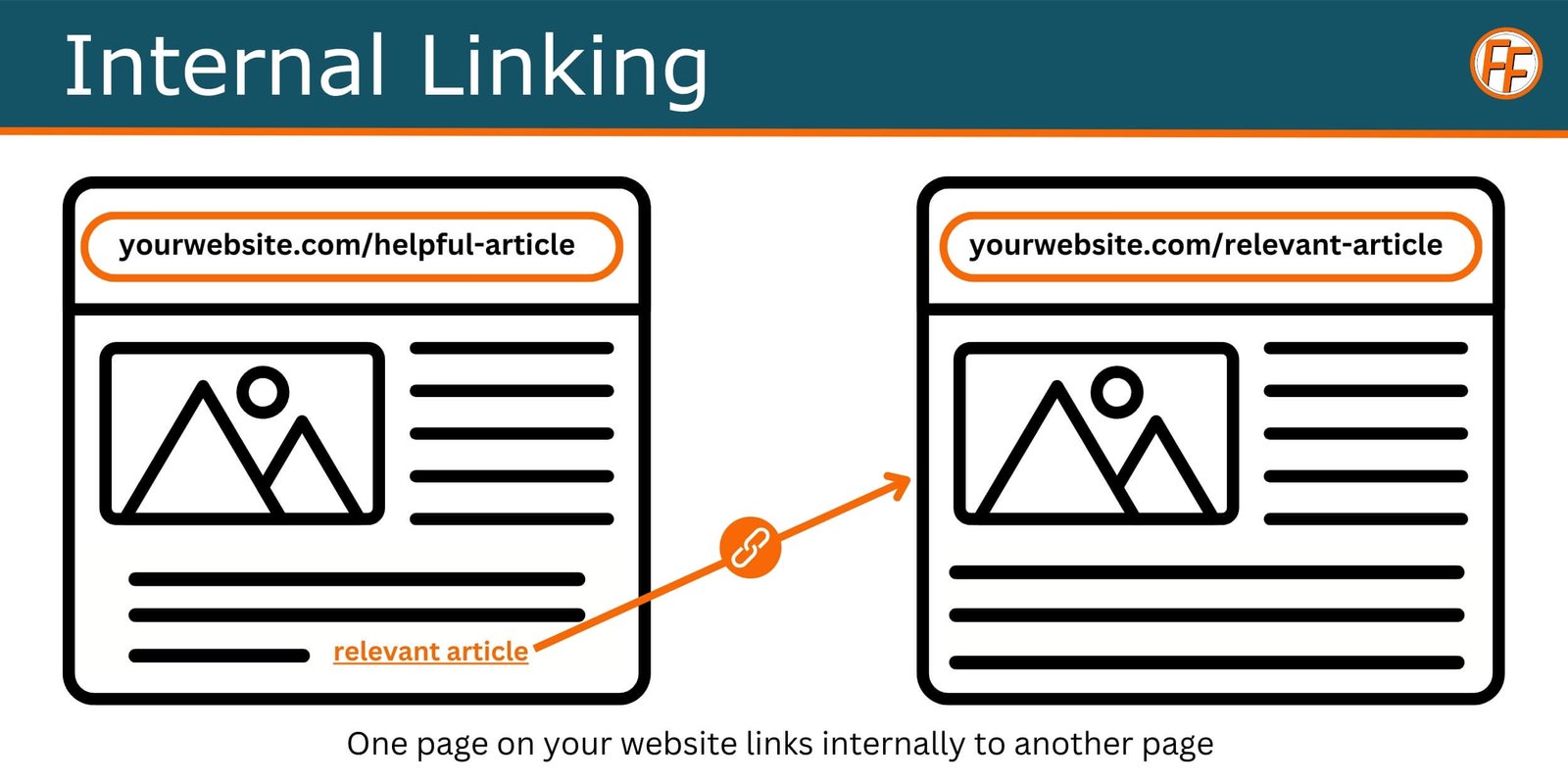
Benefits of internal linking
- Improved User Experience: By linking to relevant content on your website, you allow users to explore topics in more depth, creating a seamless journey through your site
- Enhanced SEO: Internal links help search engines understand your site’s hierarchy and the relationships between pages, potentially boosting your rankings
- AI: Internal linking clarifies content relationships and site depth, making it easier for AI systems to interpret and trust your expertise
Creating Internal Links
- Identify Relevant Content: Find a keyword phrase in your current content that naturally relates to another page on your website.
- Highlight the Text: Highlight the keyword or phrase you want to turn into a link.
- Insert Internal Link:
- In most CMS platforms, use the “Insert Link” button.
- Choose the relevant existing page from your site’s structure, or paste the URL of the page you want to link to.
Internal links should use descriptive anchor text that clearly indicates what the linked page is about, rather than generic phrases like “click here.”
Write Engaging Introduction
What Is a Hook
The hook is your opening sentence or paragraph, crafted to grab the reader’s attention and draw them in. Effective hooks might use a surprising fact, a compelling question, or a relatable anecdote to spark curiosity.
The Introductions Purpose
The introduction should clearly state the main idea or purpose of your content. Let readers know what they can expect to learn or gain from reading further.
Now this should, if you’ve read other articles on hooks and introductions, seem familiar.
What is new, however, is placing the core answer at the very beginning of your content, sometimes called front-loading.
Placing a clear, concise summary of your topic at the very beginning can help your content appear in AI-powered search results. This approach benefits both AI and human readers:
- Quick answers satisfy those who want immediate information.
- Expanded details in the rest of your article serve those looking for a deeper understanding.
Don’t make readers—or AI—dig for the answer. Start strong, then build on your main point with supporting insights and details.
Incorporate Visuals and Multimedia
It is important to give context and enhance your content with images, graphics, charts, and videos. It not only breaks up text but also reinforces your key points and improves engagement. The additional benefit is that multimedia elements can make your content more accessible for users who speak different languages or have reading or visual impairments.
Image Formats

Use the correct file type for the media you wish to include.
- JPG: Ideal for photographs due to smaller file sizes from lossy compression—best when slight quality loss is acceptable.
- PNG: Best for graphics with sharp lines and text, like logos, thanks to lossless compression.
- WebP: Offers superior compression and quality compared to JPG, improving page load speeds.
- AVIF: A newer format with even better compression and image quality than WebP or JPG, ideal for high-quality furniture photography and fast-loading pages.
However, an important consideration for both WebP and AVIF is browser compatibility. While support is growing rapidly, not all browsers currently support these next-generation file types.
Most modern SEO plugins and image optimisation tools, however, can be configured to automatically serve a fallback format (like a JPG or PNG) to browsers that don’t yet support WebP or AVIF.
Benefits of Image Compression:
Reducing the size of your images without sacrificing quality is important because it:
Speeds up your website load times, which improves user experience and keeps visitors engaged.
Boosts your SEO ranking, as faster-loading sites are favoured by search engines.
Lowers bandwidth usage, saving hosting costs, especially for high-traffic websites.
Enhances mobile browsing, where slower connections and data limits are common.
I’ve been enjoying Squoosh, which was developed by Google Chrome Labs. It has some limitations, but allows you to see a before and after, which is incredibly beneficial.
Alt Text Describing Your Visual for All
Always provide descriptive alt text for all images on your website. Alt text serves multiple vital functions. Firstly, it describes images for visually impaired users who rely on screen readers to interpret web content, making your site truly accessible. Secondly, it helps search engines (and their AI algorithms) understand the content and context of your images, which can significantly boost your visibility in image search results and contribute to overall SEO relevance. If an image fails to load, the alt text provides a meaningful description to all users.
The alt Decision Tree from W3C Web Accessibility Initiative (WAI) guides you on appropriate alt text implementation.
Videos
Videos would be better uploaded to video hosting sites, like YouTube, and then embedded in your content. This will reduce page load speed and not take up server space with large video files. Additionally, YouTube is the second largest search engine, and Google seems to favour it; funnily enough, they also own it.
Strong E-E-A-T Signals for Trust and Authority
The internet is now a vast resource for information and shopping, and AI has made this wealth of data easier than ever to access. However, to ensure the answers it provides are accurate, reliable, and helpful, both AI and Google’s algorithms place immense importance on the credibility of sources.
This is where E-E-A-T comes in – standing for Experience, Expertise, Authoritativeness, and Trustworthiness.
E-E-A-T isn’t a direct ranking factor, but a fundamental quality framework that deeply influences Google’s search rankings and user trust. For your furniture business, demonstrating strong E-E-A-T means proving you’re the go-to, reliable source for all things furniture.

Myth-busting: Some claim you can’t “add E-E-A-T” to your website. In reality, E-E-A-T is not a single feature—it’s a collection of signals and best practices that together build your site’s credibility and authority. So whilst you can’t just “add” it, you can optimise for EEAT.
Why is E-E-A-T Important?
- AI models can hallucinate: AI sometimes generate inaccurate or nonsensical information. By prioritising content from authoritative and trustworthy sources, search engines and AI aim to reduce this risk and provide more factual, helpful answers.
- Visibility in AI Overviews: If your content is seen as credible, AI and search engines are more likely to cite your website as a source, increasing your visibility—even if users don’t always click through.
- Human trust = conversions: Strong E-E-A-T builds genuine trust with your audience, which is essential for converting browsers into buyers, especially for high-value purchases like furniture.
- Algorithm resilience: Websites that genuinely embody E-E-A-T principles tend to withstand broad algorithm updates better, as they align with Google’s core mission of serving high-quality content.
How to Optimise for E-E-A-T
Experience: A Hands-On Perspective
Experience means having direct experience with the product or service that the content talks about. Searchers value content that reflects genuine, first-hand perspectives, opinions or advice shaped by actual use.
For your furniture business, this means showing how your pieces perform and fit into customers’ everyday lives, building authenticity, trust and social proof. It demonstrates that real people are using your products and provides authentic feedback.
What is not often talked about—and often overlooked—when discussing Experience is your experience in operating a furniture business. Customers, when deciding what product to buy and where to buy from, would find this experience important. While it touches on expertise, it primarily builds trust.
You don’t just know the products. You understand the realities of sourcing, inventory management, customer service, logistics, and what matters to customers. Your guidance is grounded in real-world retail experience, making you a safe pair of hands for your customers.
How can you show Experience?
- Customer Reviews & Testimonials: Real feedback about how your furniture performs in daily life.
- User-Generated Content: Photos or videos of your products in real homes.
- Behind-the-Scenes Content: Show your team, your process, or special projects—demonstrating your ongoing, hands-on involvement in the business.
- Case Studies or Before/After Stories: Highlight transformations using your products.
Experience and Expertise, discussed next, do have a significant crossover, but they are not identical.
A customer can have experience with a product (e.g., they bought your new modular sofa, used it for 6 months, and love/hate it). However, that customer is not necessarily an expert in upholstery, furniture construction, or design. They can report on their experience without having deep, technical knowledge.
Expertise: Demonstrating Deep Knowledge
Expertise goes beyond simply using a product. To become an expert, you typically accumulate significant experience over time through practice, study, and or direct involvement. True expertise is difficult to achieve without hands-on exposure and a commitment to continuous learning.
Why does expertise matter?
Expertise lends authoritativeness and high trustworthiness to your content. AI and search engines prioritise information from knowledgeable sources for factual accuracy and comprehensive subject coverage.
How to Showcase Your Expertise
- In-depth Product Knowledge: Share comprehensive product details—materials, dimensions, care instructions, and design inspiration. Address all common customer questions directly in your copy or link to tailored resources like buying guides.
- Educational Content: Create guides that help customers make informed decisions, such as “How to Choose the Right Sofa for Your Space.” This not only demonstrates your expertise but also builds trust with your audience.
- Specialist Topics: Go beyond generic overviews. For example, write a detailed comparison of leather types (aniline, semi-aniline, corrected grain) and their care requirements. This shows you understand the nuances that matter to buyers.
- Author Credentials: Display the author’s name and credentials (e.g., “Written by Gerry Cann, Head Furniture Designer with 15 years of experience in upholstery”). This signals to both users and AI that your content is produced by genuine experts.
- Answer Complex Questions: For topics like furniture materials, ergonomics, or design trends, provide detailed, accurate answers that only a specialist would know.
AI and search engines increasingly prioritise content from recognised experts, especially for complex or technical topics. Demonstrating your expertise is non-negotiable for building authority and trust in the furniture industry.
Authoritativeness: Being a Recognised Leader in Your Field
Backlinks remain a foundational element of SEO. Earning links from reputable, industry-relevant websites signals to search engines and AI that your site is a trusted source. Links from unrelated industries (e.g., British Airways for a furniture business) are unlikely to carry weight with Google, as relevance is key.
How to Establish Authoritativeness
- Earn mentions and links from respected industry sources, trade associations, and relevant publications.
- Showcase awards, media features, and partnerships to signal your reputation and credibility to both customers and search engines.
- Highlight collaborations with well-known designers, influencers, or brands—leveraging their reputation to strengthen your own.
- Encourage and display reviews on your Google Business Profile and trusted third-party platforms like Trustpilot. Responding professionally to feedback and demonstrating expertise in your replies further builds trust.
- Reputation management: Positive third-party recognition and a strong review profile reinforce your authority and trustworthiness.
High-quality, authoritative content naturally attracts mentions and backlinks from respected sources. Awards, media features, and partnerships are often a result of consistently putting out valuable content that others want to reference or highlight.
Authority signals to AI and search engines that your website is a reliable, influential source, making it more likely your content will be cited or surfaced in AI-generated overviews and search results.
Trustworthiness: Ensuring Transparency and Reliability
Trustworthiness is the backbone of customer confidence and an important factor for both AI and human users. AI models are reluctant to cite sources that appear unreliable or unsafe, making trust signals essential for visibility and authority.
Trust is not granted instantly—it must be earned over time, much like in any human relationship.
Trust Signals
What counts as a trust signal can vary, but some elements are universally recognised are:
- Transparent policies: Clearly display your returns, privacy, and shipping policies.
- Clear contact information: Make it easy for customers to reach you with visible phone numbers, email addresses, and physical locations.
- Secure shopping: Use HTTPS, trusted payment gateways, and display security badges to reassure customers.
- Responsive customer service: Quick, helpful responses to inquiries and issues build lasting trust and encourage repeat business.
As discussed in the expertise section, authorship transparency also matters. Content that is authored and then ideally reviewed by senior employees, interior designers, or furniture experts, with visible credentials or bios, further strengthens trust.
Trustworthiness is not a one-time achievement but a continuous process of demonstrating reliability, transparency, and care in every customer interaction and piece of content you publish. This ongoing commitment not only builds loyalty and conversions but also signals to AI and search engines that your site is a safe, credible source for recommendations and citations.
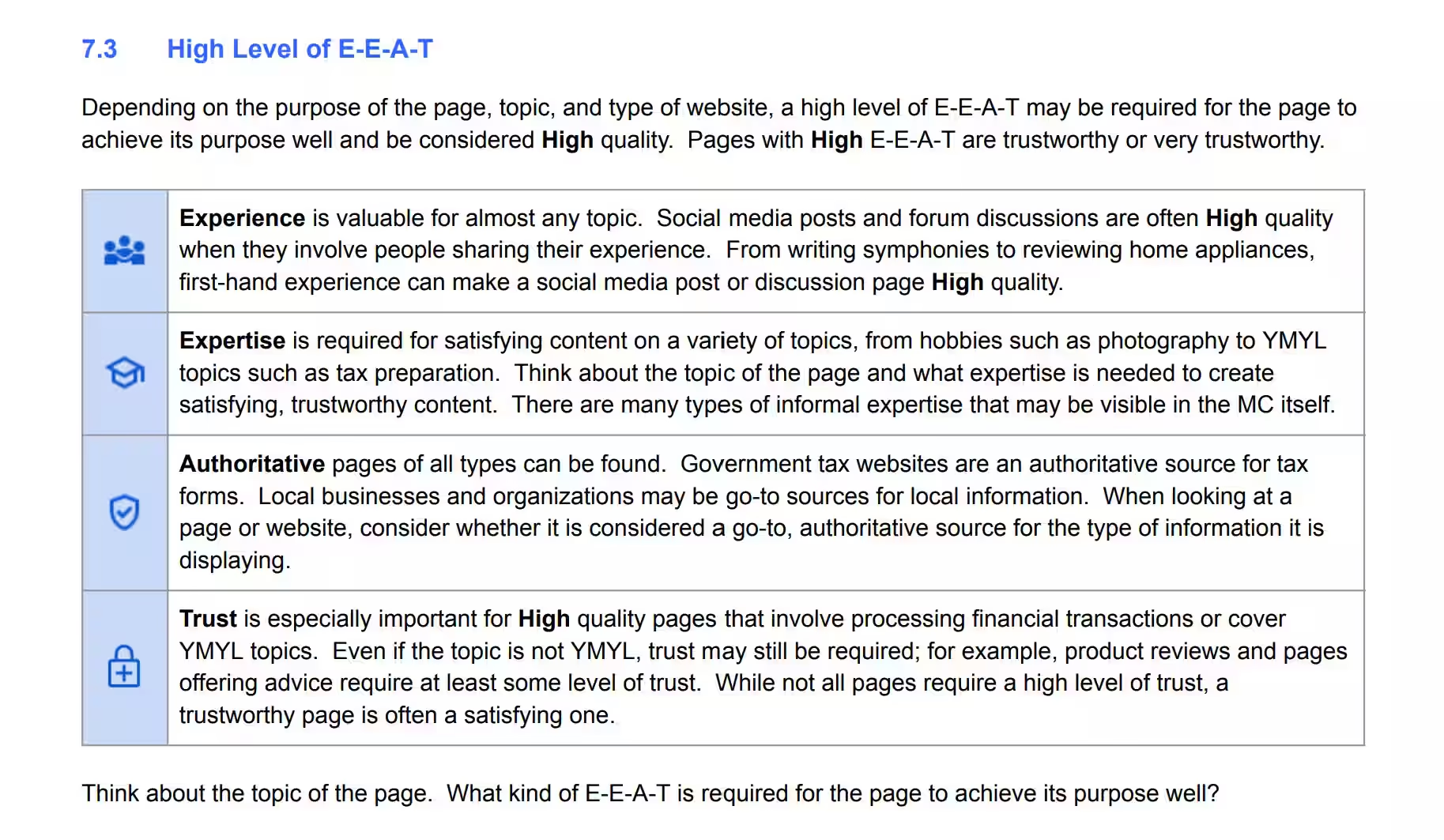
Source: Section 7.3 from Google’s search quality evaluator guidelines.
E-E-A-T: A Holistic and Reinforcing Strategy
E-E-A-T is not a fragmented checklist. The four elements—Experience, Expertise, Authoritativeness, and Trustworthiness—frequently overlap and reinforce one another.
E-E-A-T delivers the greatest results when these elements work together across your entire website and customer journey, creating a reputation for quality and reliability that both search engines and customers recognise.
Content Distribution & Promotion
Creating content is only half the battle. Even the most insightful guide won’t deliver results if no one sees it. Content distribution and promotion is the process of amplifying your content’s reach, ensuring it gets in front of your target audience.
Effective promotion increases visibility, which in turn increases the chances of other reputable sites seeing and linking back to your content, significantly enhancing your E-E-A-T and overall search authority.
Where to Distribute Your Content
Your Website: Your site is your primary hub for content. Almost all content should originate here.
Email Marketing: Send new content, guides, and promotions directly to your subscribers.
Social Media Platforms:
- Instagram & Pinterest: Perfect for photos, videos, inspiration, and “shop the look” content—ideal for furniture.
- Facebook: Share articles, promotions, polls, and host live Q&A sessions.
- TikTok / YouTube Shorts: Short, engaging videos (hacks, tours, behind-the-scenes).
Paid Advertising Channels:
- Google Ads: Search and Display campaigns for high-intent traffic and retargeting.
- Social Media Ads: Facebook, Instagram, and Pinterest ads for targeted promotion and lead generation.
Partner Networks & Collaborations:
- Interior Design Influencers: Sponsored content and reviews.
- Complementary Brands: Cross-promotion and joint ventures.
- Local Community Organisations: Local mentions and exposure.
Content Syndication & Online Communities:
- Medium / LinkedIn: Repurpose excerpts of expert articles.
- Relevant Forums / Reddit: Genuine engagement and linking where appropriate.
- Guest Posting: Contribute to reputable blogs or industry publications.
Dealing with AI Content Risks
We have talked about whether AI is all hype or helpful for your furniture business in a separate article. That piece explores the topic in greater detail, but it is important to address it here as well, especially if you are considering AI for content creation.
While AI tools offer incredible efficiencies in content creation, they aren’t without their drawbacks. AI-generated content can introduce significant risks such as factual inaccuracies, unintended plagiarism, and a dilution or complete loss of your distinct brand voice. Without proper oversight, these issues can severely damage your credibility and erode customer trust, which is important for a business like yours dealing in high-value purchases like furniture. Oversight is essential to ensure that your content maintains the highest standards of quality, accuracy, and originality, safeguarding your brand’s reputation in the long run.
Content Performance Measurement
Creating high-quality, optimised content is essential, but its true value is only unlocked when you can measure its impact. Content performance measurement ensures your efforts translate into tangible business results, allowing you to continually refine your strategy and maximise your return on investment (ROI).
Begin by defining what success looks like for your business. Move beyond traditional traffic metrics and consider the broader impact of AI-driven search. For example, monitor your visibility in AI Overviews—recognising that while direct clicks might decrease, increased brand exposure can lead to future direct visits and customer engagement. Pay close attention to branded searches and direct traffic, as more searchers see your company featured in AI summaries and then choose to research your brand name or visit your site directly.
Other vital KPIs include engagement metrics like time on page, scroll depth, and bounce rate, alongside micro-conversions such as e-book downloads (e.g., “Guide to Small Space Furniture”) or newsletter sign-ups. Ultimately, measure direct online sales (number of sofas, beds sold), and the revenue generated is the ultimate measure for your furniture content.
Content Freshness—Staying Relevant
Information changes rapidly, and content can quickly become outdated. Both human readers and AI systems actively seek out the most current and relevant information available. When content is out of date, it can easily become inaccurate or even misleading, which can undermine trust in your brand.
AI models are specifically designed to prioritise the most up-to-date answers. When generating an AI Overview, these systems will naturally favour sources perceived as current and authoritative. For example, an outdated article on “2023 Furniture Trends” or a “Mattress Buying Guide” that hasn’t been updated in five years is unlikely to be cited by an AI seeking the best and most relevant advice.
As AI agents become more sophisticated, they may increasingly rely on your website for real-time information, such as product availability, pricing, and current promotions. If your content is outdated, it could lead to incorrect responses from the AI, which may frustrate or mislead potential customers.
For real human users, seeing recent updates or the latest information inspires confidence in your business. Google’s quality raters provide feedback that helps inform search algorithm improvements and are instructed to assess content freshness and flag outdated material. Websites that consistently provide fresh, accurate content are regarded as higher quality and are more likely to be recommended by both search engines and AI systems.
Legal and Ethical Considerations
This section is about safeguarding your brand and building trust, so don’t skip it. your content is more than just a marketing tool or communication. It is also a reflection of your brand’s integrity and commitment to compliance.
Legal and ethical considerations should not be mere checkboxes to tick. Compliance and ethical standards build deep, long-term trust with your customers. Demonstrating commitment to these standards reassures customers that they are dealing with a responsible and reputable company. Ignoring them risks significant financial penalties, reputational damage, and loss of consumer confidence.
Copyright: Respecting Intellectual Property
Use only licensed or original images and text, and always credit sources appropriately. Copyright law (in the UK, the Copyright, Designs and Patents Act 1988) automatically protects creative works such as photographs, illustrations, and written content. Using copyrighted material without permission is illegal and can lead to financial penalties, takedown notices, and damage to your brand’s reputation.
Privacy: Upholding Data Protection Laws
Make sure that you fully comply with all relevant data protection laws, notably the UK GDPR and the Privacy and Electronic Communications Regulations (PECR). Provide clear, easily accessible privacy policies and obtain explicit consent for data collection and processing where required. This is especially important if you intend to track content performance or collect personal data from users.
Transparency: Openness in Content Creation and Promotion
Disclose sponsored content, affiliate links, or any significantly AI-generated or AI-assisted material. Honesty builds trust. Consumers value knowing when content is promotional or created with technological assistance. Regulators like the Advertising Standards Authority (ASA) in the UK require clear disclosure for marketing communications to avoid misleading consumers. While Google’s stance on AI content prioritises quality over creation method, transparency with users about substantial AI involvement in content can enhance trust.
Accessibility Laws: Ensuring Digital Inclusivity
Your website and content must meet relevant accessibility standards, such as the Web Content Accessibility Guidelines (WCAG) 2.1 AA (or higher), which is widely adopted in the UK and internationally.
Accessibility laws aim to ensure digital content is usable by everyone, including people with disabilities. Non-compliance can lead to legal action and alienate a significant portion of your potential customer base. A fully accessible site also often performs better in SEO due to a clear structure and semantic markup.
Honest Marketing: Avoiding Misleading Claims
I shouldn’t have to include this, but I will. Always adhere to the principles of honest and truthful marketing, avoiding misleading claims, exaggerations, or deceptive practices in all your content. The Advertising Standards Authority (ASA) and Competition and Markets Authority (CMA) in the UK regulate marketing communications. False claims can lead to complaints, investigations, forced ad withdrawals, fines, and significant reputational damage. Customers expect transparency, especially when making significant purchases like furniture.
Optimising Furniture Content in the AI Era
As we’ve discussed throughout this article, optimising your furniture content for the AI era requires more than simply applying a series of isolated tactics. Every element we’ve covered—from clear formatting and structured data to demonstrating E-E-A-T and maintaining content freshness—is interconnected.
When creating content, it’s important to anticipate the follow-up questions your audience might have. Consider what related topics or next steps a reader could be interested in and plan connected articles or resources that address those needs. This not only enhances the user experience but also strengthens your site’s topical authority.
AI Overviews and conversational agents aren’t designed to stop at a single answer. Just like a human assistant, AI will anticipate the next logical query a user might have, aiming to provide a comprehensive response that covers the entire user journey.
This approach reinforces the importance of semantic referencing, as discussed in our keyword research guide. Modern AI systems strive to understand the intent behind queries and evaluate the breadth and depth of your expertise across an entire topic. To be recognised as an authority, your content must demonstrate a thorough understanding, covering subjects from multiple angles rather than focusing on isolated keywords. This comprehensive coverage—often organised as topic clusters—is precisely what AI values when selecting sources for complete and accurate overviews.
Your content strategy should reflect this same level of foresight. When planning and creating content, think like AI: anticipate user needs, connect related topics, and build a cohesive, authoritative presence.
When creating content, we must think like AI. Adopt the AI DNA.


